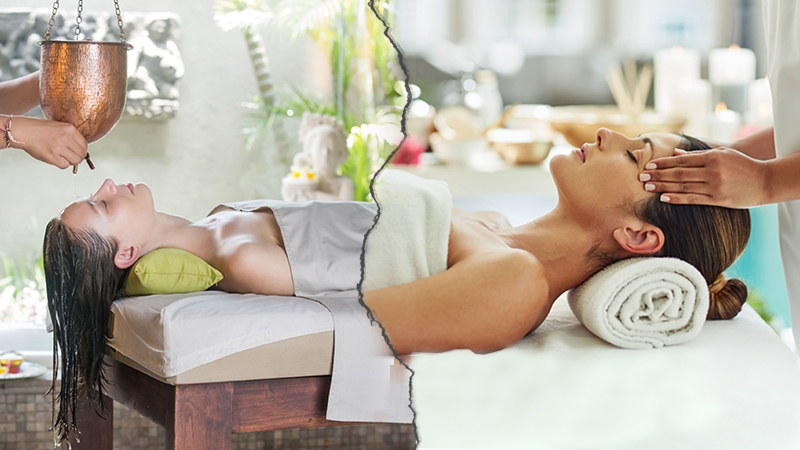Traditional Versus Contemporary Ayurveda Spa
In the bustling wellness world, where ancient traditions meet modern innovations, the clash between tradition and contemporary practices is perhaps most evident in Ayurveda spas.
Ayurveda, the ancient Indian holistic healing system, has gained global recognition for its natural and rejuvenating therapies. Among the various facets of Ayurveda, Ayurvedic spa have become immensely popular, offering a blend of relaxation, wellness, and cultural experience. However, with the evolution of time and technology, Ayurvedic spa have also undergone significant transformations. This article delves deep into Ayurvedic spa, comparing the essence of traditional practices with the innovations of contemporary approaches. By exploring the roots and branches of Ayurvedic spa treatments, we can understand the balance between heritage and modernity in the pursuit of wellness.

Traditional Ayurveda Spa: Preserving Ancient Wisdom
Traditional Ayurveda spas are sanctuaries of ancient wisdom. Rooted in centuries-old practices, these spas adhere strictly to the principles outlined in the ancient Ayurvedic texts. The therapies offered here are based on individual doshas (Vata, Pitta, and Kapha) and are meticulously designed to restore the balance of these life forces. Each therapy celebrates traditional healing methods from Abhyanga (oil massage) to Shirodhara (oil pouring treatment).
- The Healing Touch of Traditional Therapies
Traditional Ayurveda therapies focus on the power of touch. Therapists, well-versed in the nuances of Ayurvedic massages, use specific strokes and techniques to stimulate energy points and channels in the body. This touch therapy is believed to ease physical tension and promote mental and spiritual well-being.
- Rituals and Therapies In Traditional Ayurvedic Spa
Traditional Ayurvedic spa treatments often commence with Abhyanga, a therapeutic oil massage that balances the doshas and promotes relaxation. This is followed by Swedana, an herbal steam therapy detoxifying the body. Shirodhara, where warm herbal oil is gently poured onto the forehead, induces deep relaxation and balances the nervous system. Panchakarma, an intensive detoxification process, is another hallmark of traditional Ayurvedic spa. These therapies are rooted in centuries-old wisdom and are meticulously designed to bring harmony to the body and mind.
Contemporary Ayurveda Spa: Bridging Ancient Wisdom With Modern Needs
The surge in global interest in Ayurveda has led to the evolution of contemporary Ayurveda spas. While rooted in traditional principles, these spas have adapted to cater to the fast-paced lifestyle and varied needs of the modern clientele. They blend ancient wisdom with modern techniques and amenities to offer a holistic wellness experience.

- Fusion Therapies: Merging Tradition With Innovation
Contemporary Ayurveda spas often offer fusion therapies that combine traditional Ayurvedic treatments with modern techniques such as aromatherapy, hydrotherapy, and even elements of Traditional Chinese Medicine. These hybrid therapies aim to provide a comprehensive healing experience, addressing physical ailments and mental stressors.
- Modern Techniques In Contemporary Ayurvedic Spa
One of the significant advancements in contemporary Ayurvedic spa is the incorporation of specialized therapy equipment. For instance, hydrotherapy, which utilizes water jets and mineral baths, enhances the traditional spa experience. Additionally, aromatherapy, where essential oils are used to promote relaxation and well-being, has become a popular choice. Yoga and meditation sessions in contemporary Ayurvedic spa are often augmented by virtual reality technology, providing immersive and serene environments for practice.
Comparison: Tradition Versus Modernity In Ayurvedic Spa
Ayurveda, the ancient science of life, has transcended centuries, evolving and adapting to the ever-changing tapestry of human existence. This ancient wisdom finds itself at a crossroads in the contemporary world, where traditional Ayurvedic spa and their modern counterparts coexist, each offering a distinct approach to wellness. Let’s dive deeper into comparing these two paradigms, shedding light on their nuances.
- Philosophy And Approach
Traditional Ayurvedic spa adhere strictly to the principles outlined in ancient Ayurvedic texts. The approach is deeply rooted in the belief that the human body is a microcosm of the universe and that balance is the key to health. Traditional spas follow the holistic approach, addressing physical ailments and mental and spiritual well-being. The treatments are based on the individual’s dosha, emphasizing the restoration of doshas balance.
Contemporary spas, while honoring the core principles of Ayurveda, often integrate modern philosophies. They recognize the impact of contemporary stressors and environmental factors on health. The treatments are adapted to cater to specific health issues prevalent in the modern world, such as chronic stress, digital fatigue, and lifestyle-related disorders. The focus is on a personalized approach that incorporates ancient wisdom into the context of contemporary challenges.
- Therapies And Treatments
Traditional Ayurvedic therapies are time-tested rituals passed down through generations. These therapies, such as Panchakarma (a detoxification process) and Marma therapy (a therapy focusing on energy points), are designed to purify the body, enhance energy flow, and promote holistic healing. The therapies use herbal oils, natural ingredients, and precise techniques from ancient sages.
Contemporary Ayurvedic spa often offer a fusion of traditional therapies with modern techniques. This fusion includes treatments like Ayurvedic facials, herbal ingredients, and specialized massages combining Ayurvedic principles with aromatherapy or hot stone therapy. These innovative treatments cater to individuals seeking the traditional essence of Ayurveda with a touch of modern luxury and comfort.
- Customization And Personalization
Traditional spas rely on the wisdom of experienced Ayurvedic practitioners. Diagnostics involve in-depth consultations, pulse analysis, and detailed examinations of the individual’s constitution (Prakriti) and imbalances (Vikriti). Therapies are personalized based on these assessments and the individual’s dosha. In traditional Ayurvedic spa, treatments are meticulously personalized after in-depth consultations with Ayurvedic practitioners. The focus is on individual dosha imbalances, ensuring targeted healing.
On the contrary, while offering personalized treatments, contemporary Ayurvedic spa often provide predefined packages catering to specific wellness goals. This standardization allows for a more streamlined experience, ideal for those seeking quick relaxation and rejuvenation. Contemporary spas leverage technology for precise diagnostics. Advanced tools and software help analyze Doshas imbalances, enabling practitioners to create highly personalized wellness plans. This technology integration ensures accuracy and allows a deeper understanding of the individual’s health profile.

- Ambiance And Atmosphere
Traditional Ayurvedic spa often embrace the rustic charm of traditional Indian architecture and natural surroundings. The ambiance is serene, with Ayurvedic herbs wafting through the air. Traditional Ayurvedic spa often immerse visitors in an ambiance reminiscent of ancient healing centers. The décor, music, and even the architecture reflect the cultural heritage of Ayurveda. The serene atmosphere encourages visitors to connect with their inner selves and nature.
In comparison, contemporary Ayurvedic spa focus on creating luxurious and modern environments. These spas often feature state-of-the-art facilities, soothing lighting, and ambient music, providing a cocoon of comfort for the guests. The emphasis is on creating a sensory experience that complements the healing therapies. The ambiance is designed to provide a modern, comfortable experience. High-end amenities, plush furnishings, and state-of-the-art facilities enhance the spa experience, offering luxury and tranquility.
- Role Of Technology
Traditional Ayurvedic spa rely on skilled therapists whose hands are their primary tools. In contrast, contemporary Ayurvedic spa leverage technology for various purposes, including diagnostic tools to assess dosha imbalances accurately. Additionally, online consultations with Ayurvedic experts have become prevalent in modern spas, breaking geographical barriers and providing access to renowned practitioners worldwide.
Embracing The Duality Of Ayurvedic Spa Wellness
Ayurvedic spa, both traditional and contemporary, play a pivotal role in promoting wellness and relaxation. While traditional spas preserve the ancient wisdom of Ayurveda, contemporary spas innovate to cater to the diverse needs of a global audience. The key lies in finding a balance between tradition and modernity, ensuring that the essence of Ayurveda is preserved while embracing the benefits of scientific progress.
In the choice between traditional and contemporary Ayurvedic spa, the decision ultimately rests on individual preferences. Some may seek the authenticity of age-old practices, valuing the connection to ancient traditions. Others may prefer the convenience and innovation offered by contemporary spas, appreciating the amalgamation of modern techniques with traditional wisdom.
How to Choose Between Traditional and Contemporary Ayurvedic Spa?
Choosing between a Traditional Ayurvedic Spa and a Contemporary Ayurvedic Spa can be challenging, as both offer unique experiences and benefits. To make an informed choice, consider the following factors:-
- Understanding Your Needs
Traditional Ayurvedic Spa: A traditional spa might be the right choice if you seek an authentic, deeply spiritual experience rooted in ancient Ayurvedic practices and rituals. Traditional spas are ideal for those who want a more personalized approach with treatments tailored to their dosha imbalances.
Contemporary Ayurvedic Spa: A contemporary spa might be a better fit if you are looking for a more streamlined and modern experience that integrates ancient Ayurvedic wisdom with innovative techniques and technologies. These spas often offer a wider range of services and cater to a broader audience.
2. Budget and Accessibility
Traditional Ayurvedic Spa: Traditional spas might be more budget-friendly, especially those in regions where Ayurveda originated. However, the quality of services can vary, so it’s essential to research and read reviews to find a reputable spa.
Contemporary Ayurvedic Spa: Contemporary spas, especially those in urban areas or luxury resorts, tend to be more expensive due to their modern amenities and high-end services. Consider your budget and the value you place on the services offered.
3. Health Conditions and Consultation
Traditional Ayurvedic Spa: Traditional spas often consult with experienced practitioners who assess your health conditions, lifestyle, and dosha imbalances before recommending treatments. If you have specific health concerns, a traditional spa might be better equipped to address them.
Contemporary Ayurvedic Spa: Contemporary spas offer consultations, but the approach might be more standardized. A contemporary spa could be suitable if you have common wellness goals and prefer a more general approach.

4. Atmosphere and Preferences
Traditional Ayurvedic Spa: If you prefer a rustic, authentic atmosphere with traditional Indian architecture, natural surroundings, and the aroma of Ayurvedic herbs, a traditional spa is ideal. The focus here is on creating a spiritual and serene ambiance.
Contemporary Ayurvedic Spa: If you appreciate a luxurious and modern environment with state-of-the-art facilities, soothing lighting, and ambient music, a contemporary spa might be more to your liking. These spas aim to create a sensory experience that complements the healing therapies.
5. Time Considerations
Traditional Ayurvedic Spa: Due to their personalized and intricate nature, traditional Ayurvedic treatments often require more time. If you have the luxury of time and seek a deeply immersive experience, a traditional spa is worth considering.
Contemporary Ayurvedic Spa: Contemporary spas often offer quicker, targeted treatments. If you have a busy schedule and are looking for efficient relaxation and rejuvenation, a contemporary spa can accommodate your time constraints.
6. Feedback and Recommendations
Traditional Ayurvedic Spa: Seek recommendations from people who have experienced traditional Ayurvedic spa in the region where Ayurveda originated. Personal testimonials and feedback can provide valuable insights into the authenticity and quality of services.
Contemporary Ayurvedic Spa: Read reviews and testimonials from guests who have visited contemporary Ayurvedic spa. Focus on spas with positive feedback regarding integrating modern techniques with Ayurvedic practices.
Consider these factors thoughtfully to make an informed decision and enjoy a rejuvenating Ayurvedic spa experience tailored to your unique requirements.
Final Thoughts –
Regardless of the choice, Ayurvedic spa, in all their forms, continue to be sanctuaries of healing, providing solace to weary souls and revitalizing tired bodies. Whether you find bliss in the gentle strokes of a traditional Abhyanga or the soothing ambiance of a contemporary spa, the essence of Ayurveda remains unchanged – a timeless journey towards holistic well-being.




